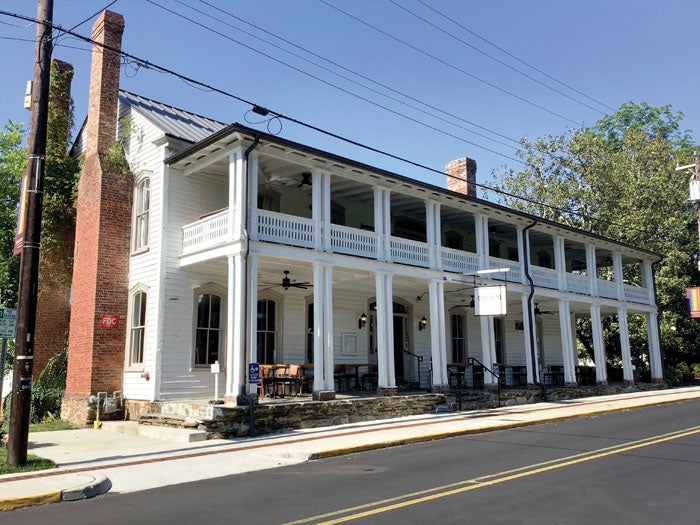Gotta’ Run: More fun in the eastern county seats
Published 12:00 am Saturday, July 15, 2023
Editor’s note: David Freeze is completing a challenge to run in a few miles in every county seat in all 100 N.C. counties. Contact him at david.freeze@ctc.net.
Leftover from a previous segment of county touring was Tarboro. On the way home from several eastern coastal plain counties, I stopped since it was close to the interstate. Tarrburg, then Tarrborough finally became Tarboro in 1760 when chartered by British colonists. On the banks of the Tar River, the town is the ninth oldest in the state and was a thriving trade center until the Civil War, when more than half of the population was enslaved. Tarboro became the county seat of Edgecombe County in 1764. George Washington slept here in 1791.
A long series of 19th century storefronts and about 300 historic residences can be seen in town, on the way to the 15-acre Town Common. The Town Common originally surrounded the town and is the second-oldest legislated town common in the country. Initially the location for common grazing of livestock, community gatherings and military drills, the Town Common is the only remaining original common on the east coast besides the one in Boston, Massachusetts. I missed N.C.’s last remaining cotton press located there too. The Edgecombe County Courthouse was completed in 1965, but in a style called Modern Colonial Revival that makes it look old. More recently, Tarboro experienced severe flooding from Hurricane Floyd in 1999 and Hurricane Matthew in 2016.
Next stop was Hillsborough, the county seat of Orange County. On the Eno River, the town was built on the site of Native American settlements that existed from 1000-1710. I found a booming farmer’s market and the Riverwalk on the Eno near the oldest part of town. Founded in 1754, it was not until 1766 that the town was named Hillsborough, after Wills Hill, then the Earl of Hillsborough, the British secretary of state for the colonies, and a relative of royal Governor William Tryon. The Regulator Movement increased tension as local residents and British colonial officials clashed when some of those locals took up arms protesting taxes and seizure of land, resulting in the loss of six lives by hanging.
The town was also the site of the first North Carolina ratifying convention, which met July 21-Aug. 2, 1788, to deliberate and determine whether or not to ratify the Constitution recommended to the states by the Constitutional Convention held in Philadelphia the previous summer. The meeting was held at the Hillsborough Presbyterian Church. A later building, constructed in 1816, still stands. Declaration of Independence signer William Hooper was buried at the same church but his remains were moved later. There are more than 100 surviving late 18th century and 19th century homes and the town, once known as the “capital of the back country”, still looks much the same as it did then. The historic Orange County Courthouse was built in 1844 and has a clock presented to the town by English officials. The inns and several of the oldest homes have the modern sidewalk next to the front steps.
I made the short drive to Snow Hill, county seat of Greene County. Snow Hill was chartered in 1828 and was originally a major trading depot on Contentnea Creek. At the time, Contentnea Creek was a main Wilson-to-New Bern trading artery, connecting with the Neuse River at Kinston. The name Snow Hill is thought to refer to the white sand banks of Contentnea Creek.
Snow Hill, considered the smallest town to ever do so, fielded a professional Class D baseball team called the Billies from 1937-1941. The Greene County Courthouse was built in 1935. Beautiful historic homes dominate the quiet streets. Only a handful of retail businesses exist today.
Next up was Greenville, county seat of Pitt County, founded in 1771 as “Martinsborough,” named after the Royal Governor Josiah Martin. In 1774 the town was moved to its present location on the south bank of the Tar River, three miles west of its original site. In 1786, the name was changed to Greenesville in honor of General Nathanael Greene, the American Revolutionary War hero. It was later shortened to Greenville.
Greenville had several steamboat lines plying the Tar River with passengers and goods by the 1860s. Cotton and eventually tobacco fueled the local economy. The Pitt County Courthouse was built in 1910. In 1999, Hurricane Floyd dropped 17 inches of rain, mostly overnight, and caused the Tar River to flood at a 500-year level. Major flooding and damage occurred in town. In early 2020, the city council authorized the purchase of approximately 163 acres of land north of the Tar River for the development of an adventure park focusing on outdoor recreational activities such as running, hiking, biking and camping along with lake-based and river recreation. Greenville features a greenway system of more than nine miles that connects the medical and educational community with the Uptown District and Tar River. East Carolina University is the fourth largest university in the UNC system.
The Greenville historic district had some real gems. I talked with Jeremy Law, chef and owner, at the SOCO restaurant. He said the house, built about 1895, was moved twice and held together well. The Fleming house next door, built in 1901, was also spectacular. George Washington also visited Greenville in 1791. The Proctor Hotel, built about 1912 with an “air of refinement,” had undergone renovation in 2004. The downtown area was not busy on a Friday evening, but just a short walk away several restaurants were very busy in what is called Uptown Greenville.
With this writing, we’re now at 69 county seats visited with 31 more to go. Most of the counties remaining are well east of Rowan. And speaking of Rowan, I’ll do it last. Back soon with more!




















